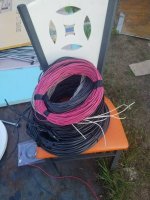farm boy00
Veteran Member
- Joined
- Jul 17, 2014
- Messages
- 1,297
- Location
- Howard City, MI
- Tractor
- John Deere M&MT, Case 1030 comfort king, Sears ST16, Craftsmen 6000, homemade articulation mini-loader
What is the real difference between regular commercial wiring and automotive? Only thing I can think of is automotive is more flexible but I could be wrong?
Asking because I'm doing some aftermarket lights on a 98 ford ranger and have piles of commercial wiring out of a restaurant and it's all free. My plan was to use some 8ga with a fuse for main line to toggle switches then 12 ga to lights. Yes I know 12ga is over rated but it's free.
Picture is just some of what I have.
Asking because I'm doing some aftermarket lights on a 98 ford ranger and have piles of commercial wiring out of a restaurant and it's all free. My plan was to use some 8ga with a fuse for main line to toggle switches then 12 ga to lights. Yes I know 12ga is over rated but it's free.
Picture is just some of what I have.
